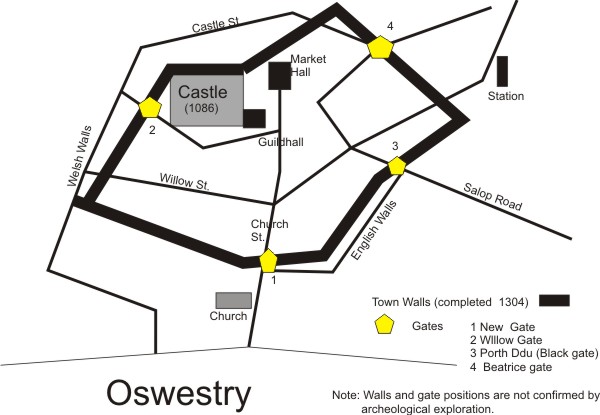Historians have searched high and low for Wem's missing market charter. It was believed to have been granted by King John in 1202
(or 1205) to the Warin FitzGerald on behalf of his ward, William Pantulf, permitting Wem to hold a market on a Sunday and on the
Feast of St Peter until Sunday markets were forbidden in 1351 and market day was changed to Thursday. Now, thanks to Dr Judith
Everard's work on Wem for the Victoria County History, it appears that it never existed. The detective work has been meticulous -
confusion with another town Highworth in Wiltshire where FitzGerald also had manorial rights has led many a person on a merry and
fruitless dance. Highworth was known as Worth. The relevant entry in King John's abbreviated it to W~ followed by a space, as
if the writer intended to insert the full spelling later. This was interpreted by Lloyd as Wem and used as a source by Garbutt.
In addition, William Pantulf was not FitzGerald's ward and there is doubt as to whether this particular "William" existed.
Wem's castle was built around the 1140s, and in line with many Norman plantation towns, a market would have been established
fairly quickly near the castle gates. By the time that King John embarked on granting market charters, another of his very
many money-raising ventures, Wem's market would have been long up and running. It is likely that along with other market towns
where the existence of the market was not contested, Wem did not bother to apply for a market charter. Additionally market
charters cost a lot of money and so why encourage a king known for his avarice?
Does this affect the status of Wem as a market town The short answer must be (No!) If Wem had squatter's rights (or grandfather's rights)
to hold a market in the 11th and 12th centuries, then that must hold true for the 21st century.
For the full background, see the Wem Short (VCH) below.
Relaunch of Victoria County History in Shropshire
The Shropshire Victoria County History for Shropshire was relaunched on 31st October 2015
at the Guildhall in Shrewsbury. The first scheduled project would be a history of Wem, due to appear in late 2016
or early 2017. (Delayed, but now published.)
Wem Civic Society was involved in this development.

At the launch, two lecturers provided details of the structure and details of the Marcher towns. Dr Barrie Trinder
examined the buildings and occupations through photographs, while Dr Keith Lilley of Queens University Belfast
looked at the structure of Marcher towns.
Dr Lilley used his own, and other established models, to illustrate
how the towns had grown. He showed how many, such as Ludlow, had developed around a strong fortress, with a
broad market place leading from it. Straight parallel streets of housing filled the gap between the fortress
and the outer walls of the town. In some cases, such as Beaumaris and Conwy, the street pattern of one could be
superimposed on that of the other, showing that the same town designer had been at work. In other Marcher towns,
e.g. Hereford, he showed the way both in which the Norman town had been fitted onto the previous Saxon settlements,
and the subsequent developments along feeder roads. While Lilley did not cite Oswestry, he mentioned how the development
of walls affected that of the streets. There, the need for outer walls because of raids both from Llewellyn ap Gruffyd
in the west, and from the inhabitants of Maelor Saesneg to the east, made it vital that Edward I fortify the town.
Murage tax was raised and the walls were developed with 4 gates,leaving the commercial centre within the walls but
leaving the existing church outside.
The walls survived until dismantled during the civil war. Names of roads have been affected, e.g. of English Walls
and Welsh Walls. Little trace of the walls remains today but streets that cross them would either have been truncated or have had their routes substantially changed.
A report of the work on the Wem Short was given on Sunday 18th June 2017 by Victoria County History - Shropshire At a Wem History Day. The first item on the agenda was the Wem Charter.
Four short talks on VCH's research into the history of Wem were given.
Programme:
- The missing market charter: rewriting the history of Wem', Judith Everard, see above.
- Understanding the urban landscape of Wem', James Bowen
- "The thing was done which the parishioners since wished undone": The Developmental History of Wem Parish Church, Wendy Horton
- Two centuries of Wem farming, Richard Hoyle